Menu
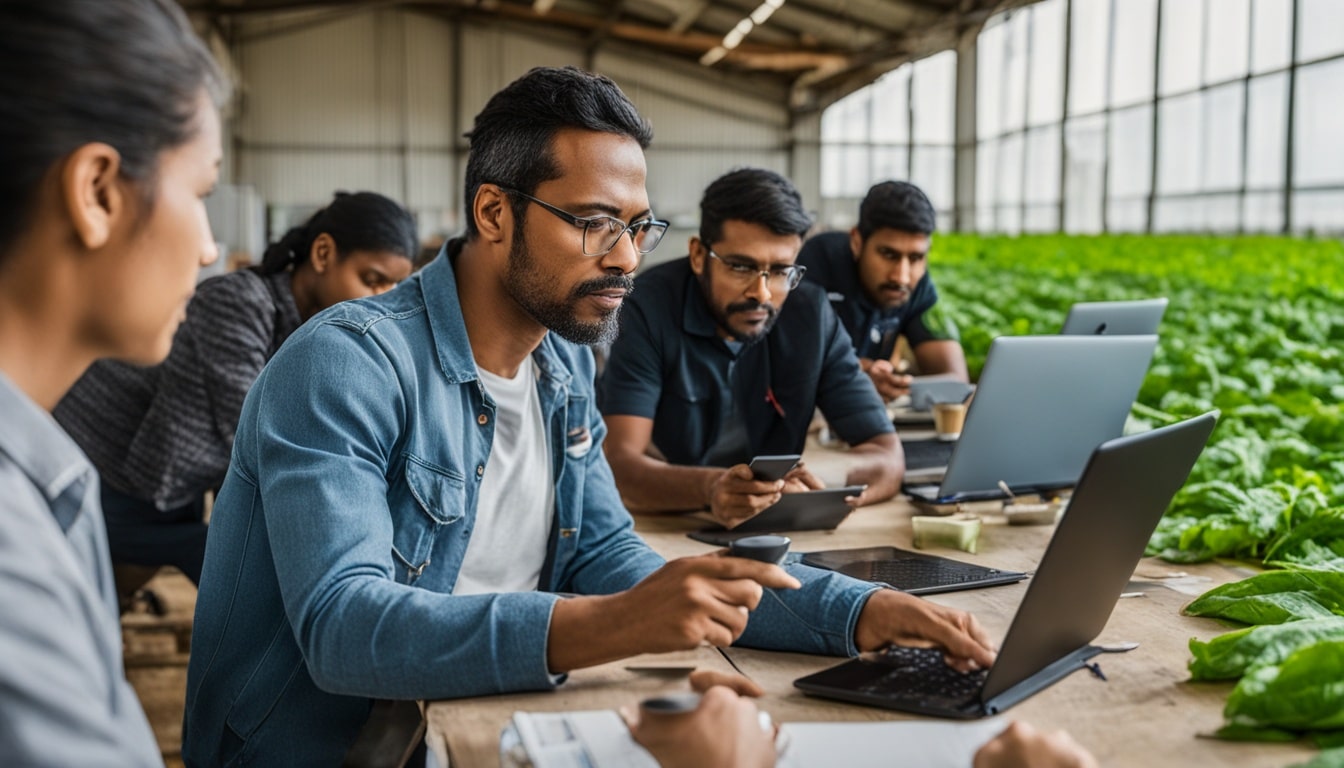
Did you know that using digital tools in farming can make farm management 30% more efficient? In today’s farming world, it’s crucial to teach staff to use these tools. Things like Google Classroom are now changing how farms work, by making training and everyday tasks easier.
Digital tools give farmers a way to keep training materials nice and tidy. This includes how-to videos, the way things should be done, and little tests. This helps the team know exactly what to do and follow the farm’s rules well. It also means that important farm information stays up-to-date, all through a digital system, rather than old-fashioned ways like using a whiteboard.
Farming has changed a lot in recent times due to digital tools. Today, these gadgets are not new but are key to making farms run better and produce more.
Digital tools have changed how farming works. They were scary at first for some small farmers. But now, things like real-time data and AI are proving how useful they are.
These tools help farmers decide when to plant, how to deal with bugs, handle water, and manage risks. Farming has become more efficient and makes more money because of them.
Digital tools help farmers save a lot of money. They do this by being very precise about what the crops need. This means less waste and lower costs. Using water better also saves money.
The Monarch Tractor MK-V is an example of how powerful automation can be. It cuts the need for more workers, makes working safer, and uses less weed killer. Governments also help by giving out tax breaks and rebates to those who use these tools.
Consumers want food made in sustainable ways. Digital tools help with that. By showing real-time data on plants and farm resources, decisions are smarter and kinder to the environment. Managing farm records is also easier and more accurate with digital tools.
Learning how to use these digital tools is very important. As more farms use them, everyone needs to know how to make the most of them. This helps both small and big farms be more productive and clean.
Modern farming relies heavily on advanced machinery for better efficiency. Staff need training to make the most of these complex tools for top performance. Training covers everything from basic equipment use to high-tech solutions like using digital tech in farming.
New farming tools change the game. Equipment like GPS tractors, automated planters, and systems for Variable Irrigation Rates are now normal. They let farmers work smarter over larger areas. As less than 5% of cattle are electronically tagged, there’s a move towards more tracking tech to avoid food issues. These advances cut costs, raise productivity, and increase harvests.
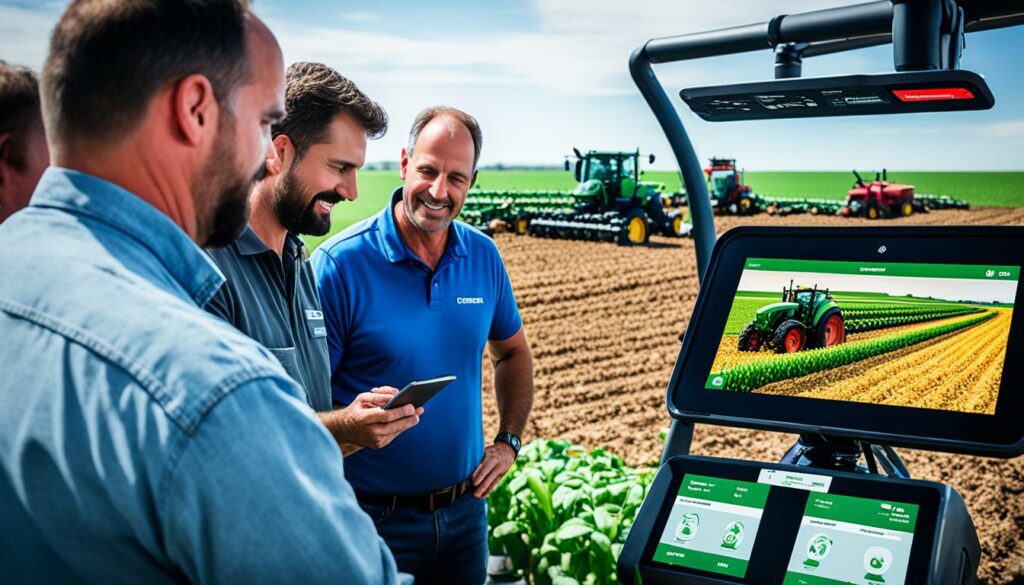
Digital tech improves how we manage farm tools. AI and other tech are fast and can crunch large amounts of data. They help with predicting market demands and the best times for farming activities. For farmers, this means better training and knowledge to efficiently use the latest tools. Also, IoT sensors and AI can help manage crops on their own, use water better, and support eco-friendly farming.
Many farmers, especially in remote areas, find it hard to access technology. But, as digital tools become easier to get and their benefits clearer, farming is getting more efficient and eco-friendly. Training staff well in using modern tools is key. It ensures they’re ready to meet the demands of a growing population.
Automation in agriculture, like driverless tractors and AI-based robots, is changing things for the better. It’s making farming more accurate, cheaper, and needing less human work.
With the right knowledge, staff can make the best use of new farming equipment. This boosts productivity and makes farm work more sustainable. As we bring in new tech, the need for good farm equipment training keeps growing.
| Technology | Benefit |
|---|---|
| GPS Mapping | Accurate data for crop management |
| VRI Systems | Effective water distribution |
| AI Algorithms | Optimised resource use and crop yield prediction |
| IoT Sensors | Autonomous crop management |
| Blockchain Technology | Tracking goods from farm to table |
Agricultural technology is a mix of tools and systems changing how farms work. These innovations let farms boost their performance, handle resources better, and choose better through data. Agricultural technology training provides key info and real-world skill. It links old farm ways with new tech.
Agricultural technology includes Geographic Information Systems (GIS), the Internet of Things (IoT), drones, and artificial intelligence (AI). Each tech is important in today’s farming:
Key farming technologies like self-driving tractors, exact water use systems, and robots are changing farming. Products like the Monarch Tractor’s MK-V save a lot. They cut costs about 60% in California. This is a big saving for the long run. Also, they offer important data, from how the tractor moves to the best way to use space. This helps make farming better managed.
Joining hands-on agtech workshops helps farmers and workers get used to new tech. They learn precision farming methods. This boosts how much farming produces. Plus, it’s better for nature. The change to digital farming, thanks to tech like AI, is making farming more efficient. It’s also making a path for farming that earns more and lasts longer.
Today, in agriculture, hands-on agtech workshops are key for learning. Taking part in these has helped me a lot. They turn book knowledge into real skills for modern farming challenges.
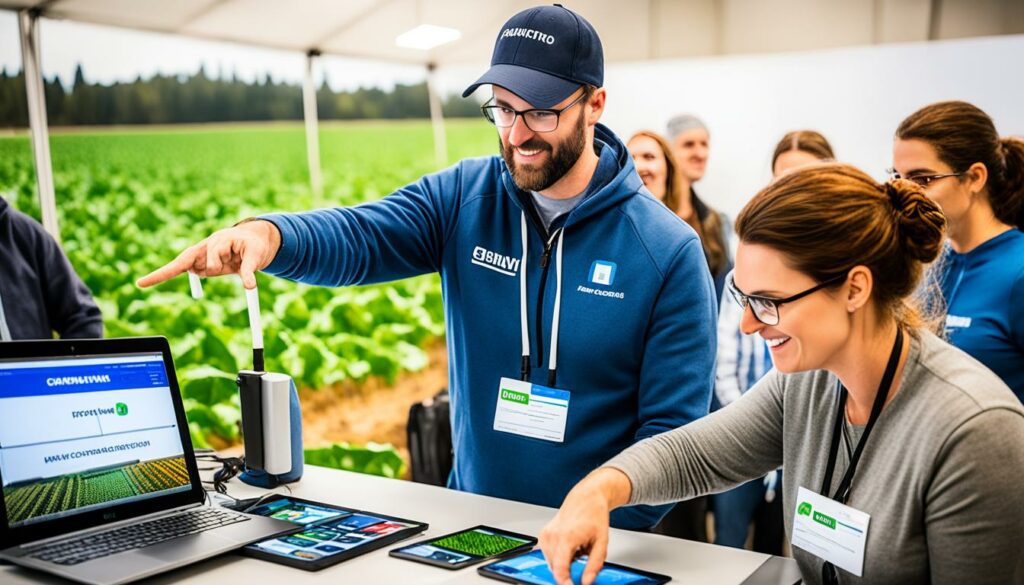
At these workshops, we mix what we learn with what we do. We try out big data, IoT, and more on the field. This makes our understanding stronger and boosts our skills for farm work.
The modules at the workshops are very engaging. They include simulations, hands-on activities, and visits to farms. We get to know AI, drones, and more in a fun and useful way.
| Program Component | Details |
|---|---|
| Duration | 2 weeks full-time + 6 weeks part-time |
| Fee | $150 CAD + tax |
| Total Training Hours | 130 hours |
| Covered Technologies | GIS, IoT, drones, AI, robotics, big data |
| Skills Gained | Project management, business development, problem-solving, team-building |
| Career Opportunities | Precision Agronomist, Agribusiness Development Manager, Precision Agriculture Specialist, AgTech Software Engineer |
| Language Requirement | CLB Level 8 or IELTS 6.5 overall |
| Residency Requirement | Saskatchewan |
| Work Experience Required | 3 years outside of studies |
| Program Offerings | Mentorship, coaching, industry-specific training, networking, job search assistance, simulation-based learning |
| Full-time Participation | Week 2 & 3, Monday to Friday, 9:00 am – 5:00 pm |
| Part-time Participation | Week 1 (~2 hours/day), Weeks 4-8 |
| Topics Covered | Precision Agriculture, Big Data & IoT, Agribusiness Digital Management Tools, Soil Management |
| Alumni Success | Ag Data Scientist, GIS & Fur Harvest Analyst, Senior Procurement Specialist, Process Engineer |
| Practical Assessment | Over 70% of participants found the workshops practical and well-organised |
| Workshop Leadership | Best-in-class STEM educators |
| Classroom Supplies | Free supplies provided |
| Industry Engagement | Site visits, professional guidance and support |
| Real-world Application | Immediate implementation of curriculum |
Using digital tools in agriculture follows a clear path to succeed. It’s vital to go through three key parts: planning, picking the right tools, and then putting them to use. Each stage is important for the overall success.
Initially, you need to look closely at what your farm needs. With more people to feed, effective farming is critical. This step should look at what you’re already doing, what tech you have, and how digital tools could help most. Getting your team and others involved to share what they think can be very useful.
After knowing what your farm needs, it’s time to choose the tools. You should pick what fits the farm’s goals and activities the best. When choosing software, look at what features it offers, how easy it is to use, and if it can join with your existing tools. Technologies such as AI in drones and precision farming can increase how much you produce while using fewer chemicals.
Finally, you’ve got to get the tools working on your farm. This part includes installing everything, showing your team how to use it, and making sure it keeps working well. By doing this right, you can keep an eye on your plants’ health, water them better, and use chemicals more wisely. Making a good plan for these steps will make sure your farm runs smoother and greener with the help of AI.
Below is a table summarising key statistics highlighting the impact of digital tools in farming.
| Statistic | Data |
|---|---|
| Global Population Projection | 10 billion by 2050 |
| AI in Agriculture Market Growth | From USD 1.7 billion in 2023 to USD 4.7 billion by 2028 |
| AI Detection Accuracy (Apple Black Rot) | Over 90% |
| North American Productivity Increase (Precision Farming) | 4% (2002-2018) |
| Precision Farming Efficiency (Fertilizer Application) | 7% Improvement |
| Pesticide and Herbicide Use Reduction | 9% |
In today’s fast-growing farming world, precision agriculture training is key. This 130-hour program is crafted to boost your skills with new tech. It covers areas such as GIS, IoT, drones, AI, and big data.
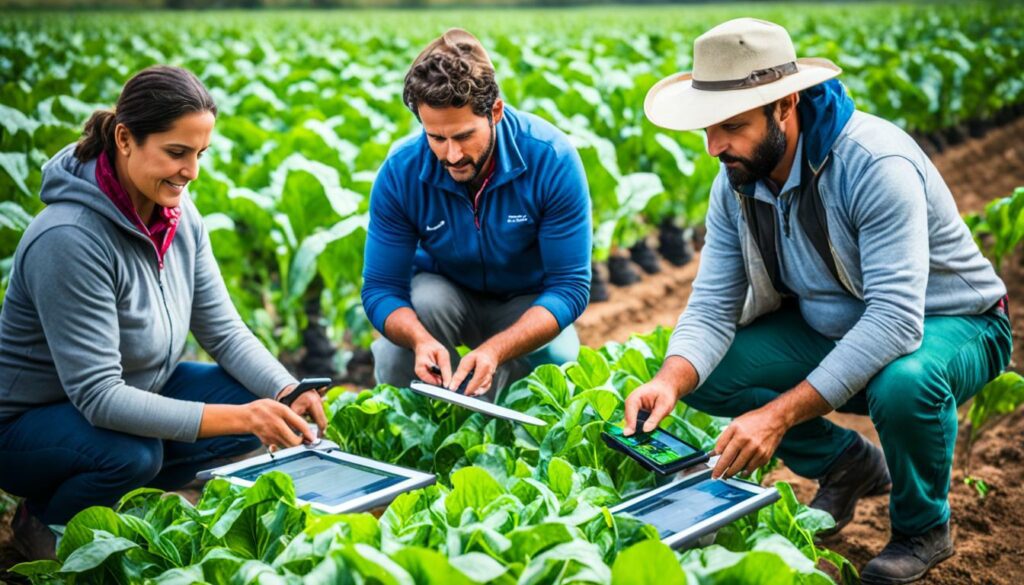
This course is set over 8 weeks, mixing part-time with full-time online work. Here’s the breakdown:
The cost is $150 CAD plus tax, making it affordable for those keen to learn. But, to apply, you need a post-school certificate and three years of work. You must live in Saskatchewan and be allowed to work in Canada full-time.
This training is all about blending new tech like GPS and GIS into farming. These tools help make better decisions and manage resources smarter. This boosts farm methods and production a lot. The program includes hands-on workshops, mentorship, and help finding work in the industry.
After finishing, you could get jobs like a Precision Agronomist or AgTech Software Engineer. This shows how well the program preps you for work.
You’ll also learn business and soft skills and meet top agri-tech companies. Alums praise the networking, expert advice, and help for job interviews. They say it makes a big difference in their confidence and job readiness.
For more on these training chances, visit the Automation and Digital Agriculture Specialist Program.
Google Classroom is a great tool for training farm staff. It’s easy to access and use, and it’s free with a Gmail account. By using this, farms can ensure their workers have the knowledge and skills they need. It makes the training process smoother for everyone.
Setting up Google Classroom is simple. A template can be used for new hires. It might include paperwork, safety videos, and materials about prevention of harassment. This makes creating a full training plan easy and keeps all training materials in one place.
Google Classroom lets you make training materials just right for the farm. You can easily share documents and videos. There’s a guide to help with this. It ensures the training fits the farm’s unique needs. Adapting the training this way is key to making it really work.
Managing training progress with Google Classroom is straightforward. You can set up assignments to check what new hires learn. Teachers can always update the materials. Plus, they can see how well students are doing with quizzes. This means they can give feedback to help improve learning.
Google Classroom helps make training interactive. Staff can give feedback and take quizzes. They can also join in discussions. Having multiple teachers makes learning more interesting. It gives different points of view and support. This way, the training is not only interesting but sticks with the staff better.
Google Classroom is a great fit for farm training. It’s flexible and easy for everyone to use. It makes setting up, tracking progress, and involving staff fun. This helps farms have a successful training programme.
Our world’s population is set to hit 9.8 billion people by 2050. This means we need to boost how much food we can grow and do it in a way that looks after the planet. Using big data and the Internet of Things (IoT) in farming is a key way to achieve this.
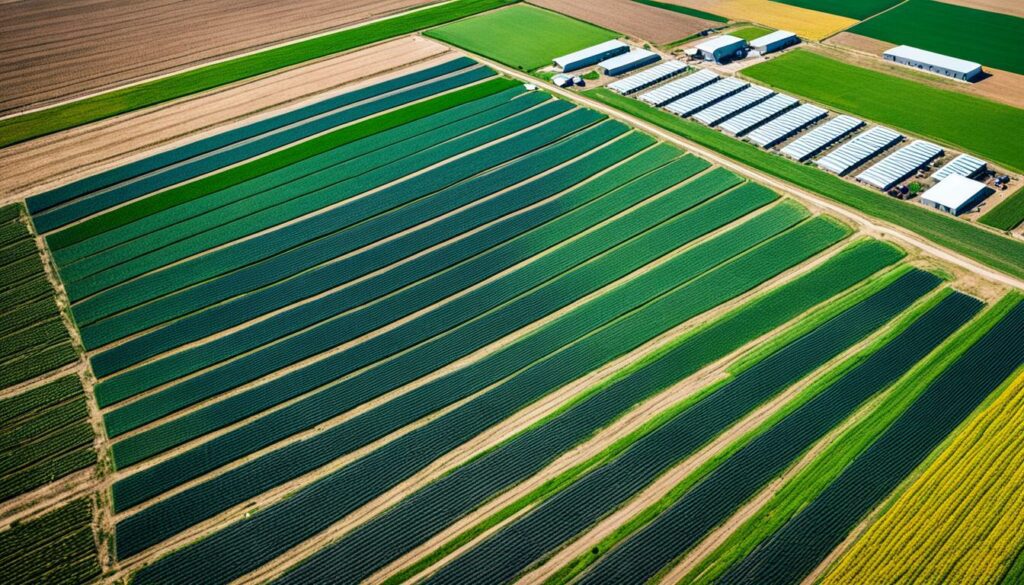
The use of analytics in farming is expected to almost double from USD 585 million in 2018 to USD 1236 million by 2023. This shows that more and more people are recognising the power of digital tools in agriculture.
DTN, part of Schneider Electric, is leading the charge by developing top-notch tools that bring together data from different sources. This allows farmers to get precise forecasts. With such insights, they can grow more crops and spend less doing it. SMAG InVivo has also created smart mathematical models, which help users predict how much wheat they can produce successfully.
IoT technology in farming is on the rise too. Its market value was $13.76 billion in 2022, growing at a rate of 9.9%. These IoT gadgets collect data on things like how moist the soil is, the health of the crops, and the weather. With all this information, farmers can make very accurate decisions.
Did you know, for every acre of land, there can be as much as 5.5 megabytes of data? This data load increases during planting times and changes based on the type of crop. There are so many types of data collected during the farm season that show just how complex farming can be.
| Statistics | Value |
|---|---|
| Population increase by 2050 | 2.2 billion |
| Farmland decrease in the US (2014-2018) | 14 million acres |
| Agricultural analytics growth (2018-2023) | 16.2% CAGR |
| Food wasted annually | One-third of produced food |
Using big data and IoT in agriculture is crucial for meeting the needs of our growing global population. These technologies help farmers use resources more wisely, support smart decisions, and enhance crop health predictions. The end result is more food grown. This helps ensure we can feed everyone in the coming years.
Agricultural automation workshops are key to learning advanced farm tech. They dive deep into automation concepts and their real-world use in farming. Participants get a detailed look at how robotics and AI are changing the game.
These workshops aim to make farming automation clear and practical. They’re vital for people working in agriculture to understand and use new technologies. This knowledge boost is essential for farming to be more efficient and productive.
Participants will learn a lot about robotics, sensors, and precise farming. This will help them handle complex farm tasks with skill and accuracy. The course lasts for 130 hours over 8 weeks, giving a strong foundation in automation and digital agriculture.
The sessions cover many high-tech farming tools. Things like IoT, GIS, drones, and machine learning are highlighted. Students will get to try out these technologies first-hand, which is a key part of the learning process.
The program also includes a training bootcamp. This six-day session focuses on the latest farming tech and how to use it in practical ways.
Here are some important points about the program and workshops:
| Component | Details | t
|---|---|
| Program Length | 130 hours over 8 weeks | t
| Program Fee | $150 CAD + tax | t
| Initial Commitment | 2 hours per day in the first week | t
| Full-Time Weeks | Monday to Friday, 9:00 am to 5:00 pm | t
| Part-Time Participation | Technical workshops and career coaching for remaining 5 weeks | t
| Career Paths | Precision Agronomist, Control Systems Specialist, Ag Data Analyst, Precision Agriculture Programmer | t
| Language Requirement | CLB Level 8 or IELTS score of 6.5 overall | t
To sum up, these workshops greatly boost farming skills with a focus on high-tech tools. They ensure not just knowledge but also hands-on experience. This is crucial for success in today’s agriculture.
Farm machinery courses are key in bridging the knowledge gap in agriculture. This becomes more vital with the ongoing digital revolution. Over 149 people from 27 European countries met in Aranjuez, Spain, for the EIP-AGRI seminar. It was all about new skills for farming in the digital age. A major finding was the lack of tech knowledge stopping European farms from using new tech.
At the seminar, it was clear only a few key farming areas had embraced digital knowledge. This gap stands out especially when 44% of the EU population lacks basic digital skills. These skills are crucial for modern farming, where machines play a big role.
Farm machinery courses are not just about teaching how to operate a machine. They cover the science and theory behind farming equipment, giving workers a deep understanding. This knowledge helps farmers use technology better, which boosts their productivity. During the event, twelve farmers talked about how new tech improved their work, showing the importance of learning in this area.
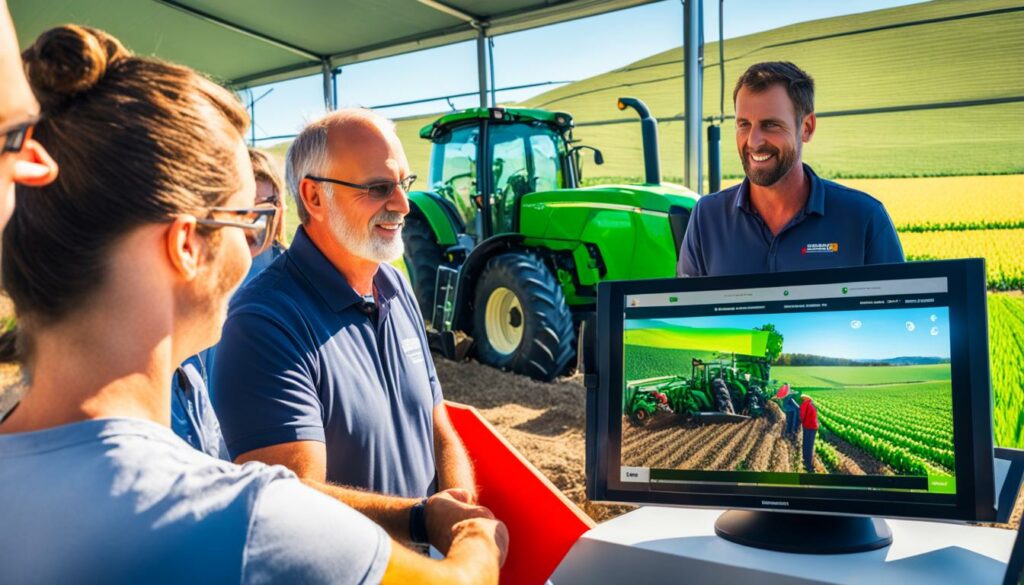
For those in remote or underdeveloped areas, these courses are even more critical. In these places, poor infrastructure and connectivity make it hard to access new technology. Farm machinery courses introduce advanced tools to cope with weather changes, soil issues, and pests. This is a big step in helping these farmers face challenges.
In the end, farm machinery courses play a vital role in reducing the industry’s knowledge gap. They better equip farm staff to use new technology. With enough support and learning opportunities, we can prepare all farmers for the future of agriculture.
Today, using digital innovations is key to farming success. The Automation and Digital Agriculture Specialist Program teaches vital skills in digital farming. This includes best practices in agricultural training to make sure education in farm technology is top-notch.
The course offers the right mix of theory and hands-on learning. It lasts 130 hours over eight weeks. At the start, you’ll study part-time for about two hours a day in the first week. Weeks two and three require you to study full-time from 9:00 am to 5:00 pm. Then, part-time again for the rest, with workshops and career advice sessions.
To join, you need at least CLB Level 8 in English, or an IELTS band 6.5. This is to make sure everyone can communicate well during the training. You must also have a post-secondary education and three years in a relevant field. The cost is good value at $150 CAD plus tax.
After completing the course, you could work as a Precision Agronomist, AgTech Software Engineer, or Automation Technologist. Building a network is also important, as it can boost your career prospects significantly.
The initiative is supported by seven industry partners through the Digital Farmer project. It offers practical modules and up-to-date information on agriculture 4.0. This helps boost farm technology education and the understanding of the latest farming technologies.
Participants can also benefit from the MOOC Digital VET Trainer in Agriculture. It teaches skills for effective online learning. Plus, the Network of Digital Farmers allows you to share successful methods with others. This creates a great learning space for everyone involved.
By using current training and keeping up with new tech, farms can become more productive and sustainable. Today’s farming is more profitable and efficient thanks to advances like mechanisation. This has made lands more workable and cut down on labour costs significantly.
Only by learning and adapting to new technology, farm staff can stay at the top of their game. Joining digital programmes, both at home and abroad, improves your skills for the modern farm. It’s a great asset for any farming professional.
Today, using digital innovation in farming is key to making agriculture better and greener. It means using new tools and systems to change the way we farm.
More and more, farmers are using digital tools thanks to team efforts, government help, and the work of new companies. Tools such as data analysis, machine learning, and GPS boost what farms can do.
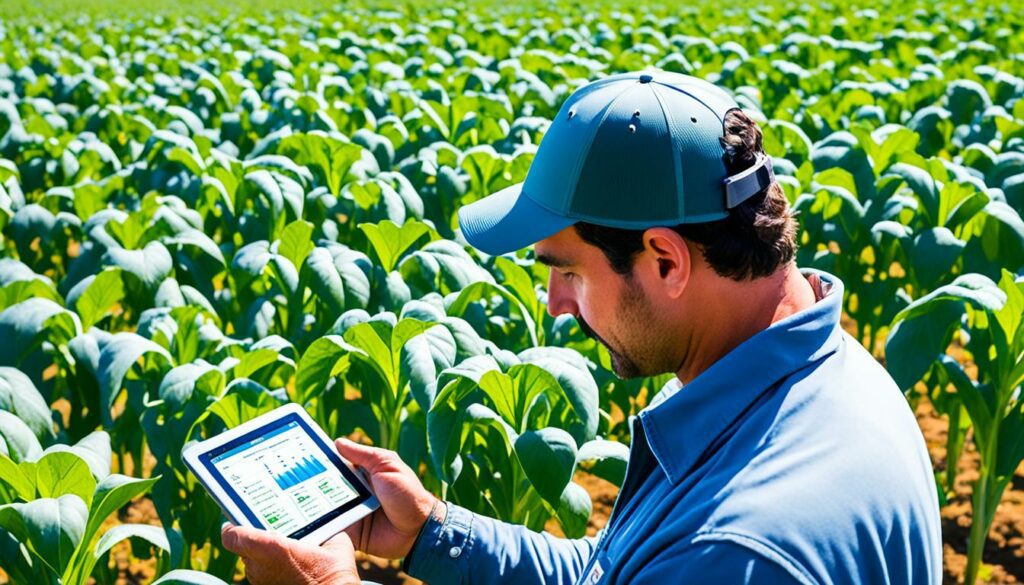
Monarch Tractor’s MK-V is a great example; it’s electric, runs by itself, and is always connected. Their tech, Wingspan Ag Intelligence, helps with real-time farming updates, making crops healthier. With these new tools, farms can use resources better, waste less, and grow more.
Stories of success in digital innovation in farming prove that new tech can really change farming for the better. For example, using self-driving tractors for fruits and vegetables has made farms work better and spend less on workers.
While these machines cost more at first, they save money in the long run, make farms safer, and use fewer harmful chemicals.
Now, people want food grown in ways that protect the planet. With new digital tools, farmers can do better at growing crops without hurting the environment.
Using tools like smart watering systems helps farms save money and water. Plus, governments are helping out by giving money to farmers to use these good technologies. This means more and more farmers around the world, especially in places like Africa, can join the digital farming change.
| Innovation | Benefits |
|---|---|
| Precision Agriculture Tools | Reduced waste, optimised farming strategies, improved yields |
| Autonomous Tractors | Increased efficiency, long-term cost savings, enhanced safety |
| Real-Time Data Analytics | Better decision-making, increased productivity, profitability |
| Government Initiatives | Financial incentives, broader adoption of agriculture technologies |
Advances in digital innovation in farming have great potential. With tech that really works, farms can become more efficient, green, and productive.
Creating a comprehensive training plan for farming is key in today’s hi-tech farms. It sets the groundwork for smart farm training. This makes sure all farm workers know the latest tech and methods. This is important for top farm management.
First, we must find out what skills are needed. This is done by talking to the team, looking at data, and assessing needs. It helps shape the training to fit what the farm needs now and in the future.
Different ways of training should be used to suit all team members. Methods include sessions with a teacher, online courses, and a mix of both. Also, interactive online sessions and videos can be helpful. They can be shared using an LMS like SC Training (formerly EdApp), which lets you train up to 10 users for free.
Take the Automation and Digital Agriculture Specialist Program, for example. It lasts for eight weeks and has 130 hours of learning. In the first week, people study part-time, then go full-time. There are also workshops and support to help with careers. This plan teaches the latest tech and readies people for jobs like Precision Agronomist.
Adding mentorship and networking can also help. It gives personalised advice and links to job opportunities. A good training plan keeps things running smoothly and boosts productivity. Big companies like Deloitte and Shell use programs like SC Training (formerly EdApp) for this.
Below is a guide on how to make a great training plan:
| Step | Action | Outcome |
|---|---|---|
| 1 | Identify Training Needs | Establishes baseline requirements |
| 2 | Define Objectives | Aligns with organisational goals |
| 3 | Select Training Methods | Ensures diverse learning experiences |
| 4 | Develop Curriculum | Creates structured learning paths |
| 5 | Implement Plan | Facilitates seamless execution |
| 6 | Evaluate and Adjust | Enhances training effectiveness |
The world of agriculture is changing fast. To keep up, farm staff need to keep learning. New farming tools and methods come up all the time. So, staff need to learn about them to stay good at their jobs.
Learning never stops in farming. It keeps farms ahead of the curve. By teaching staff about the newest tech and how to use it, farms become more efficient. This efficiency means more crops at a lower cost.
Finding ways to improve in farming is a smart process. It involves picking the right educational tools. For example, there’s a great course that teaches about new tech like drones and AI. This course offers a lot of hands-on experience. Plus, it’s designed with help from tech companies and schools to make sure it fits the industry.
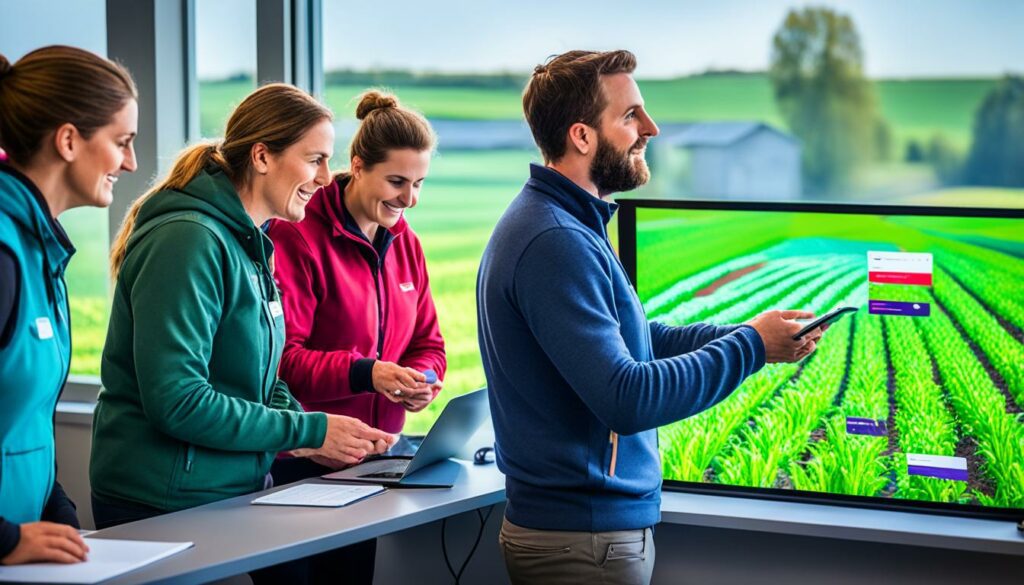
This course isn’t easy. It starts part-time for the first week, with just 2 hours a day. Then, it ramps up to full-time for the next two weeks. After this, you’ll have 5 more weeks of part-time work and coaching. By the end, you’ll have learned a lot about managing projects and solving problems. These are key skills for using new farming tech.
This kind of programme shows why it’s so important to keep learning. Not just for personal growth but for farms to be better and last longer. It helps them meet what customers want and stay successful in the long run.
| Training Component | Duration | Focus Areas |
|---|---|---|
| Part-time Participation (First Week) | 2 hours/day | Initial Setup, Basic Concepts |
| Full-time Virtual Participation (Weeks 2-3) | 8 hours/day | Advanced Technologies, Practical Implementation |
| Part-time Workshops & Coaching (Remaining 5 Weeks) | Varies | Technical Skills, Career Coaching, Real-world Projects |
Learning non-stop in farming is key. It means farm staff are ready for all the new tech and methods. This way, farms can stay successful and keep up with the latest in agriculture.
Overall, training farm workers to use digital tools is key in tackling farming’s modern challenges. These tools help staff learn new skills, making agriculture more efficient and productive. Around the world, big programs and projects, like the EU’s Horizon, the US’s agriculture research, and Japan’s Society 5.0, show how important digitalisation is for farming innovation.
AI technologies in precision farming cut down on waste and increase crop harvests. They can, for example, detect pests or diseases early through satellite imagery. This protects crops better. Technology from companies like Intel, with tools such as OpenVINO, improves the accuracy of these processes. They make sophisticated solutions available to all farmers, from big businesses to small operations.
However, challenges exist, especially where the internet is poor, and people don’t know much about digital tools. Governments, tech firms, and schools need to work together to tackle this. They can build better digital networks and teach people how to use the tech. This way, we can shape a future where farming is better equipped to handle rough weather and ensure we have enough food. Looking ahead, I believe skilled workers will lead agricultural innovation.
Teaching farm staff about digital tools boosts farm management. It makes the entry of new staff smoother. Also, it makes sure all staff know and follow the farm’s rules.
Digital tools help use resources better. They also help grow more crops by watching them closely.
Digital tools like big data and IoT give insights on farming. They help make decisions backed by data. This optimises how we use resources and boosts farm work.
New farm tools are now equipped with digital skills. For example, we have tractors and irrigation that work by GPS. These tools help run farms better and save resources.
Agricultural technology covers tools like GIS and drones. They collect and process data to farm more wisely. This leads to better growing methods and solutions.
Agtech workshops teach by doing. They mix theory and practice. This hands-on experience gets people ready to use technology on real farms.
Using digital tools in farms needs a good plan. Farms should pick the right software. They should also make a good plan to use these tools easily.
Precision agriculture is about using GPS and GIS in farming. This training teaches smart farming techniques. It aims to make farm work more accurate and efficient.
Google Classroom helps manage training materials easily. It tracks staff’s progress. This tool makes it simple to share quizzes and lessons, keeping training in one place.
Big Data and IoT work together to gather and use farm data. They help use resources better and improve farming. These technologies offer real-time solutions for crop health.
At these workshops, people learn about using robots and AI in farming. They focus on actually applying these technologies. They aim to improve skills in advanced farming tools.
These courses teach how to work various farming tools. They explain how these machines work. This knowledge helps staff use machinery and tech more effectively.
Good training includes teaching how to use tools right and handle data well. It also means keeping up with new tech. This way, farm staff stays skilled in using the latest technology.
Using new tech can change farming for the better. Success stories show how digital tools improve farming. They help farms work better, produce more, and protect the environment.
A good training plan finds and teaches the skills farms need. It creates a clear way to teach these skills. This makes farm staff better at running modern farms.
Because agricultural tech keeps growing, staff need to keep learning. Workshops and courses help them stay up to date. This ensures they know the latest in farming technology.